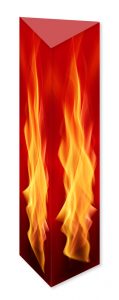Today’s post is by Pastors Melissa Bills and Anne-Edison Albright. Pastor Bills serves at First Lutheran Church in Decorah, Iowa and Pastor Edison-Albright serves at Luther College, also in Decorah. Melissa and Anne are frequent liturgical text writers for the Sparkhouse and Augsburg Fortress imprints of 1517 Media, including several collaborative projects.
January 12, 2020 marks the ten-year anniversary of the earthquake in Haiti that killed more than 300,000 people. The impact of this disaster reveals layers of trauma. In addition to the earthquake itself, a long history of colonialism, ongoing systemic oppression, poverty, racism, and climate change have all contributed to the death toll and devastation. Similar dynamics have been present in a number of other natural disasters since then. This significant anniversary gives us an opportunity to reflect upon our role and our responsibility in cultivating sustainable global partnerships. It also urges us to continue to take seriously the effects of climate change and our faithful response to the urgent need to care for the earth. On this day, we confess our complacency, we lament loss of life, and we ask God to inspire us to seek new opportunities for faithful living, among all of God’s people and throughout all of God’s good creation.
For us, the authors, this anniversary hits close to home. We are pastors in Decorah, Iowa; hometown of the Revs. April and Judd Larson, and resting place of ELCA seminarian Benjamin Splichal Larson, who died in the earthquake in Haiti ten years ago. With Ben’s family, we have been thinking about how to honor the memory of one who was very beloved and very dear, knowing that we raise our voices in prayer with countless others who are mourning and missing their beloved dear ones this day. A Witness: The Haiti Earthquake, a Song, Death and Resurrection by the Rev. Renee Splichal Larson tells more of the story, and helped us write these liturgical texts with the many layers of loss, trauma and resurrection hope in Haiti in mind. “Behold, I Make All Things New,” a liturgy composed by Ben Splichal Larson and available for free download, will be used by many ELCA congregations on this day and throughout the season.
For congregations that are marking the anniversary of the Haiti earthquake in worship on January 12, we’ve written a prayer petition that can be added to the prayers of intercession (see below). We’ve concluded the petition with words that echo the Lamb of God from ELW Setting 10, which is the song that Ben Splichal-Larson was singing when he died. We offer “Lamb of God, with us now, Give us your peace, we pray” as a way to conclude the prayers of intercession on this day.
We’ve also written a litany and prayer that can be used in many places in the worship service; we think it would go well near the beginning of the service as a Call to Worship. The litany draws on Psalm 46 and imagines how the psalmist would write the psalm if they were reflecting on the Haiti earthquake. The prayer gives options to name specific people your congregation is mourning on this day, as well as other disasters that have impacted your community or other communities close to your heart.
Thank you for praying with us, and with people all over the world, who are praying alongside the people of Haiti on this day.
Intercessory prayer petition
God our refuge, we lift up our prayers with all who mark this 10th anniversary of the Haiti earthquake. Bring an end to poverty, climate change, colonialism, and all forces that make natural disasters more profound. Empower advocates of your justice and healing, and hold in your love all who are grieving this day. Lamb of God, with us now, Give us your peace, we pray.
Call to worship:
God is our refuge and strength,
a very present help in trouble.
Therefore we will not fear, though the earth should change,
though the mountains shake in the heart of the sea;
Though its waters roar and foam,
though the mountains tremble with its tumult.
The LORD of hosts is with us;
the God of Jacob is our refuge.
Years have passed; God has not forgotten us.
God mourns with us for all that we’ve lost.
God hears our cries;
God hears the cries of the world.
Injustice and tyranny compound disaster.
We rage against powers that deal poverty and death.
The LORD of hosts is with us;
the God of Jacob is our refuge.
Listen! The people whose world shook are speaking.
God is speaking through all who are broken and healing.
God walks with us; what can we fear?
Afraid and brave, we walk together.
God is our refuge and strength,
a very present help in trouble.
The LORD of hosts is with us;
the God of Jacob is our refuge.
God, our refuge and strength, we pray with and for the people of Haiti on the tenth anniversary of the earthquake. Bless the memory of all who died in this disaster (especially), and bind our hearts together with all who continue to grieve and rebuild. Draw near to all communities and nations who have suffered natural disasters in recent memory (other natural disasters may be named). Support relief workers and international aid organizations as they generously offer themselves in time of need. Mitigate the effects of future disasters by empowering us to work for economic justice, to seek the care of creation, and to listen faithfully to the voices of our siblings across the globe. Bring hope to our hearts by your promise to make among us a new creation, where all nature is again at peace. Into your hands we commend ourselves, our world, and all for whom we pray, in the name of Christ and by the power of the Holy Spirit. Amen.
Photo Credits: Upper Right: Women return home from the market in Les Palmes, a rural village in southern Haiti where the Lutheran World Federation has been working with survivors of the 2010 earthquake, along with other residents, to experience more abundant life. Photo courtesy of Paul Jeffrey, ACT Alliance. Lower Left:Two girls walk along a street in a model resettlement village constructed by the Lutheran World Federation in Gressier, Haiti. The settlement houses 150 families who were left homeless by the 2010 earthquake, and represents an intentional effort to “build back better,” creating a sustainable and democratic community. Photo courtesy of Paul Jeffrey, ACT Alliance.
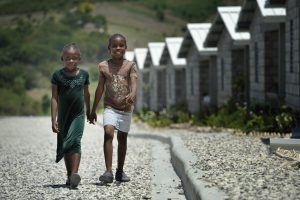

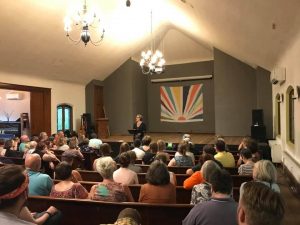
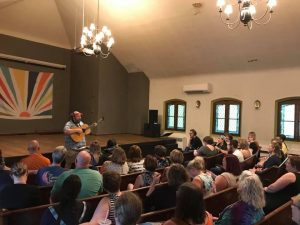 I led singing to gather us each night. One of the songs we sang each day as part of our gathering was a quote from the Sufi mystic Rumi: “Come, come whoever you are, worshipper wanderer, lover of leaving. Ours is not a caravan of despair. Though you have broken your vows a thousand times, come. Come again, come.” And in that singing we created space for everyone there, whether they sang or not, to be welcomed into this journey. We sang some paperless music, some popular songs, some requests, and some from a resource Humble Walk had recently created. Being a church poor in money, but rich in talent and volunteer spirit, they sought out used LBWs as churches switched over to ELW. Then, in order to lower barriers to participation, beautify, and simplify the hymnals, they unbound the books. They removed all but one communion service, compline, the psalms, and 50-60 hymns they would sing regularly. And finally, they rebound them in custom-made art paper to create a resource that is quirky, accessible, and matches the spirit of the place.
I led singing to gather us each night. One of the songs we sang each day as part of our gathering was a quote from the Sufi mystic Rumi: “Come, come whoever you are, worshipper wanderer, lover of leaving. Ours is not a caravan of despair. Though you have broken your vows a thousand times, come. Come again, come.” And in that singing we created space for everyone there, whether they sang or not, to be welcomed into this journey. We sang some paperless music, some popular songs, some requests, and some from a resource Humble Walk had recently created. Being a church poor in money, but rich in talent and volunteer spirit, they sought out used LBWs as churches switched over to ELW. Then, in order to lower barriers to participation, beautify, and simplify the hymnals, they unbound the books. They removed all but one communion service, compline, the psalms, and 50-60 hymns they would sing regularly. And finally, they rebound them in custom-made art paper to create a resource that is quirky, accessible, and matches the spirit of the place.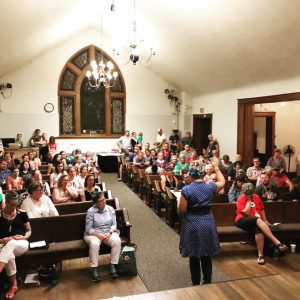

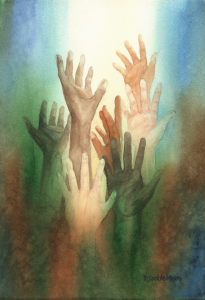 Imagine yourself suddenly, unexpectedly arrested and put in jail. You find yourself locked in a cell, perhaps with multiple strangers or perhaps all alone, staring at cracks in the concrete block, wondering what has just happened and what’s going to happen next. Whether you broke a law or whether it was all just a terrible mistake doesn’t really matter at this particular moment. You are at a crisis point in your life, and your family is probably in crisis as well.
Imagine yourself suddenly, unexpectedly arrested and put in jail. You find yourself locked in a cell, perhaps with multiple strangers or perhaps all alone, staring at cracks in the concrete block, wondering what has just happened and what’s going to happen next. Whether you broke a law or whether it was all just a terrible mistake doesn’t really matter at this particular moment. You are at a crisis point in your life, and your family is probably in crisis as well.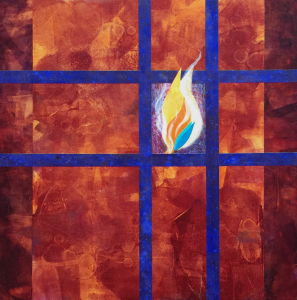 Hear My Voice was developed in collaboration between the ELCA and Augsburg Fortress, and it will be officially launched at the Churchwide Assembly in Milwaukee this August. It was developed as part of the implementing resolutions of the ELCA Social Statement,
Hear My Voice was developed in collaboration between the ELCA and Augsburg Fortress, and it will be officially launched at the Churchwide Assembly in Milwaukee this August. It was developed as part of the implementing resolutions of the ELCA Social Statement, 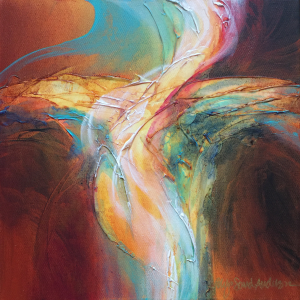
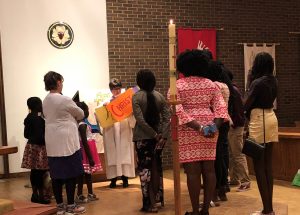 This year, after our procession was over, I gathered them around to talk about the three short statements we call the mystery of faith: Christ has died. Christ is risen. Christ will come again. I wanted them to know why we use these words in the eucharistic prayer and to be ready to shout them when we got to that part of the prayer in worship that day.
This year, after our procession was over, I gathered them around to talk about the three short statements we call the mystery of faith: Christ has died. Christ is risen. Christ will come again. I wanted them to know why we use these words in the eucharistic prayer and to be ready to shout them when we got to that part of the prayer in worship that day.

